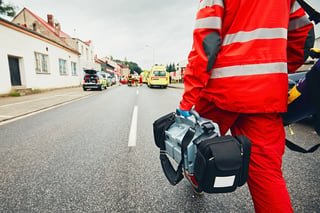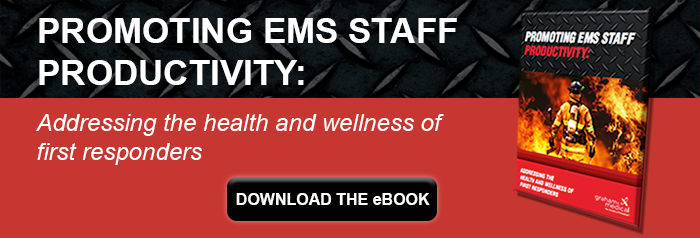 Emergency Medical Services (EMS) staff are invested in the safe care and transport of patients. You need your teams to function effectively and knowledgeably, so you ensure they receive the education and hands-on training they need. But the bottom line is that your EMS professionals need to be healthy themselves – physically and emotionally – to operate with maximum efficiency.
Emergency Medical Services (EMS) staff are invested in the safe care and transport of patients. You need your teams to function effectively and knowledgeably, so you ensure they receive the education and hands-on training they need. But the bottom line is that your EMS professionals need to be healthy themselves – physically and emotionally – to operate with maximum efficiency.
Wellness Risks for EMS Professionals
This study indicates that ambulance drivers (and other EMS personnel) are much more at risk for job-related health problems than the average population. EMS safety is a top concern.
Some of the health issues that impact EMS personnel more than the general population includes:
- Cancer
- Cardiovascular disease
- Chronic respiratory disease
- Hepatitis B, C
- Physical injuries including lower back problems
- Sleep deprivation, stress
Cardiovascular Disease – Watch for Signs
As a station chief, you’re familiar with the signs of cardiovascular failure and have trained your team to diagnose and treat cardiovascular events in patients. But the risk of on-duty heart attack deaths is 48% for volunteer firefighters. Some people can have heart attack warning signs days or even weeks before the actual event.
Risk Avoidance for Cancer Protection
Statistically, there’s a higher incidence of cancer among emergency responders than the general U.S. population. Once your team rushes into a hot zone, your chances of minimizing carcinogen exposure are slim to none. Educating your personnel to recognize the hazards before entering the exposure area and reinforcing education about the levels of protective equipment can reduce risks of absorption, inhalation, or ingestion of carcinogenic materials.
Respiratory Disease
The risk of inhalation injuries among firefighters and EMS professionals as an occupational hazard can only be lowered if you can minimize their exposure to smoke and other airborne contaminants. Please note that symptoms may take as long as 36 hours to develop. In a perfect world, you have enough personnel to rotate-out at-risk emergency responders before they are harmed; in your world, treat your team as you would patients that have suffered inhalation injury. You should consider enforcing a zero-smoking policy at the station that includes volunteers.
Hepatitis A, B Immunizations
Hepatitis A and B are preventable with vaccinations, and the majority of people with hepatitis A or B don’t know they are infected. “Tracking and accurately recording of immunizations is a vital role in any organization,” says James Sideras, a Division Chief for Sioux Falls Fire Rescue. We work in a world where disease can spread globally in days; we deploy our people to disaster sites nationwide. Immunizations against hepatitis are critical in our profession.
Reduce Work-Related Stress
In a study of EMS provider stress, two critiques emerged: When surveyed, EMS personnel said the stress-reduction support offered by their organizations seemed inaccessible or they felt discouraged from using it. What you can do : Confront negative behavior in the station that can lower morale, and put a strong, accessible stress support process in place.
EMS ‘Pain Points’
EMS personnel also have an active injury rate three times above the national average with over-exertion being a major cause. One of the ways to lower injury risks and reduce the rate of lower back injury is to promote better lifting techniques and patient transport materials.
Graham Medical, makers of the MegaMover® Transport Units is concerned with EMS health and well-being. For a more in-depth discussion of these issues please download our free eBook, Promoting EMS Staff Productivity: Addressing the Health and Wellness of First Responders.

